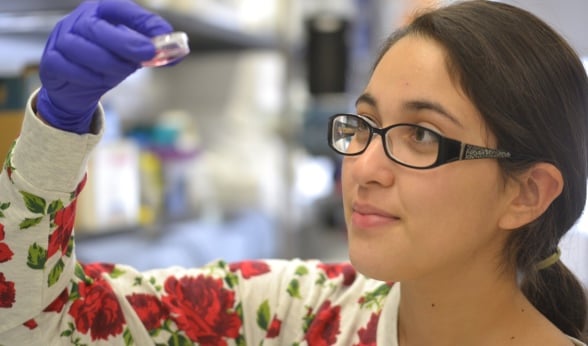“I felt so far behind,” said 21-year-old Deedee Romo about her chances of getting into graduate school. Romo, a junior biology major in CU Denver’s College of Liberal Arts and Sciences, hopes to someday become a physician.
Now, this first-generation Mexican-American student is on her way to a very impressive medical school application, thanks to the Colorado Undergraduate Research in Environmental Health Sciences (CUrehs) program.
What is CUrehs?
The brainchild of CU Skaggs School of Pharmacy and Pharmaceutical Sciences Associate Professor Jared Brown, PhD, and co-directed by John Repine, MD, and David Schwartz, MD, the program helps underserved undergraduate students interested in pursuing professional degrees in environmental health get the training they need prior to the application process.
“Underrepresented individuals” in the health sciences includes African-Americans, Hispanic Americans, Native Americans, Alaska Natives, Hawaiian Natives, U.S. Pacific Island Natives, individuals with disabilities including physical or mental impairments, individuals from disadvantaged backgrounds including financial, social, or cultural or students who are first-time college attendees in their family. Funded for five years by the National Institute of Environmental Health Sciences (NIEHS), the program assists six students at CU Denver each year.
A graduate school applicant following in the footsteps of a parent who is already a physician or PhD often has an advantage because the student knows how to navigate the system. First-time applicants with no research experience or familiarity with graduate schools are at a disadvantage when applying to professional programs.
How does CUrehs work?
For Romo, the system seemed overwhelming. “I was very concerned that I would not be able to compete,” she said. “The pathway to successfully applying to med school was confusing.”
But after being accepted into the CUrehs program, she’s one step ahead of the competition. Romo, along with five other CU Denver undergraduate students, is getting the training she needs to set herself apart.
“Most of these students have to work during their undergraduate years and don’t have the luxury of foregoing a job or taking a non-paid internship to get experience,” said Brown. “They’re excellent students in their fields, but they just don’t know how to make the leap from outstanding undergrad student to exceptional graduate student candidate.”
CUrehs helps them do that by combining practical skills like developing an effective application, writing a resume, networking and meeting working scientists with on-the-job training in a research laboratory where they are paired with a mentor based on their research interests. The students develop a research project, analyze the data, provide a final report and professionally present their findings to fellow scientists—all while getting paid.
‘More than a summer job’
“This is more than a summer job doing lab maintenance, cleaning pipettes and glassware,” Brown
said. “We really wanted to provide a valuable experience and give them a leg up while developing an interest in environmental health careers.”
The difference between this and other programs is that the CUrehs program requires a one- to two-year commitment from the student. Most programs are two months in length and occur during summer break. CUrehs provides a paid summer research program of eight weeks and a year-round research opportunity up to 10 hours per week. The program is focused on training students in the environmental health sciences. This includes research opportunities in biomonitoring of environmental exposures, genetics of environmental lung diseases, nanotechnology health and safety, environmental causes of cancer and effects of chemical warfare agents and inhaled pollutants.
Romo did her summer research at the Anschutz Medical Campus in the laboratory of Alison Bauer, PhD, studying pulmonary disease and its connection to secondhand smoke. For her, the opportunity provided by CUrehs has been life-changing: “It has been an amazing experience. It’s more than I imagined.”
By Dana Brandorff, Director of Communications & Alumni Affairs
Skaggs School of Pharmacy and Pharmaceutical Sciences


